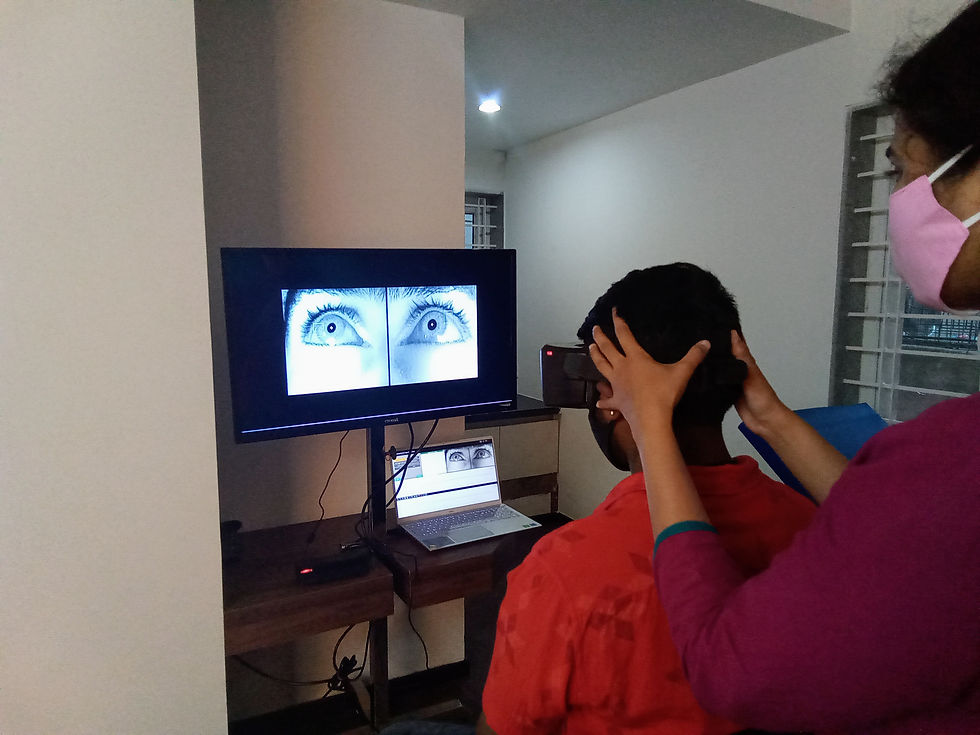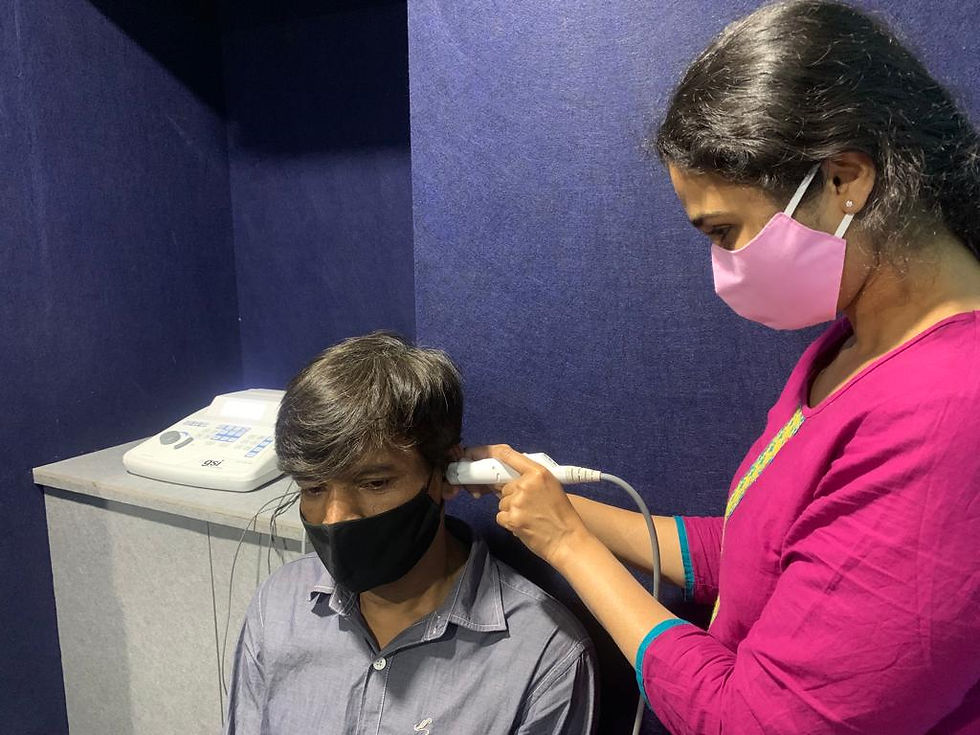
SERVICES
Your well being is at the core of our practice
Our team is brought together by the common goal of providing the best possible care and treatment to our patients with hearing problems. BHII brings together a multidisciplinary team of ENT surgeons, Audiologist, Speech & language pathologist and other support staff who provide innovative and individually tailored treatment plan for all types of hearing, speech, voice and language disorders. We have the best AVT room, Vertigo clinic and state-of-the-art audiology equipments with highly reliable results. Our expertise is provided from two serviced locations in Koramangala, Bangalore. The team will ensure the best standard of care and infrastructure in our centre and all our affiliated hospitals
Assessments

Pure Tone Audiometry
Pure Tone Audiometry (PTA) relies on single frequency tones, or "pure tones," which are transmitted via air and bone conduction pathways. The subject must respond by raising their hand or pressing the response button every time they hear the test tone. As the intensity of the tone is varied, the audiologist attempts to determine at what level the patient responds at least 50% of the time. These levels are known as the audiometric thresholds for that frequency. An audiogram is plotted based on the thresholds for all the frequencies, which gives information about the type and severity of hearing loss.
.jpg)
BEHAVIOURAL OBSERVATION AUDIOMETRY(BOA)
BOA is a test used for infants less than 6 months of age to observe their hearing behaviour such as startle, head turn, eyeblink, changes in respiratory pattern, cessation of activity in response to the sound. For the BOA testing, two clinician are required. One to handle test equipment, other one to monitor baby's behavioural response.

VISUAL REINFORCEMENT AUDIOMETRY(VRA)
VRA is administered on children as young as 5 month and is typically recommended up to roughly 24 months of age. It is the hearing measurement using a conditioned localization response and visual reinforcement. It has two phases, conditioning phase - where baby is conditioned to respond to the sound by looking at the visual reinforcer and testing phase- where actual threshold is considered once the baby is conditioned.
.jpg)
TANGIBLE REINFORCEMENT OPERANT CONDITIONING AUDIOMETRY (TROCA)
TROCA is a test approach originally described for the use with difficult to test patients, such as those with developmental disabilities. It is useful with children between 2 and 4 years of age. child is required to push a response button or make another simple motor response upon hearing a tone and tangible reinforcement is provided instead of visual.
%20(1).jpg)
CONDITION PLAY AUDIOMETRY(CPA)
Children between about 2 and 5 years of age are often appropriate for the testing, CPA uses toys to direct the child’s attention on the listening task and turns it in to a game. The first part of CPA involves conditioning the child (eg: to drop the ball in the bucket every time hear the sound). Once the child is comfortable with the task, testing phase is began where actual thresholds of the child is considered.
Acoustic Immittance
Acoustic immittance testing is to evaluate the function of the tympanic membrane and the muscle reflexes surrounding it.This testing helps in localizing the site of lesion. Acoustic immittance testing may include tympanometry and/or acoustic reflex testing. Tympanometry is a measurement of middle ear function. The response (mobility) of the tympanic membrane to this sound is measured at different air pressure levels
The Acoustic Reflex Threshold (ART) is the sound pressure level that elicits stapedial muscle contraction.. Ipsilateral and contralateral evaluation of acoustic reflexes is performed to assess the integrity of the acoustic reflex pathway.

Eustachian Tube Dysfunction

Eustachian tube dysfunction is one of the most common problem seen in patient with sinus infection, allergies and middle ear pathology. Eustachian tube is a narrow tube that connects back of the nose to the middle ear. It is normally closed, but opens up during swallowing, chewing and yawing. ET equalizes air in the middle ear and drains fluid from the middle ear. If ET is not functioning adequately or if there is any blockage it can lead to eustachian tube dysfunction. Patient with this condition can have ear fullness, ear pain, muffled hearing and ringing in the ear.
Methods to assess Eustachian tube function are:
Valsalva test:
In Valsalva test , initially a regular tympanometry is done to obtain the baseline tympanogram of the patient. Then Valsalva maneuver is performed where patient is asked to close the mouth and the nose , blow hard so that cheeks puffs up and air enters the ears . Later second tympanogram is obtained . If the eustachian tube is normal , during Valsalva maneuver positive pressure will build up in the middle ear resulting shift in the peak pressure in the tympanogram. Then patient is asked to swallow several times and third tympanogram is obtained to determine if pressure has returned to the baseline tympanogram.
Toynbee Test :
Toynbee test is similar to the valsalva test just that Toynbee maneuver is followed. To perform this test the patient is instructed to close the mouth and nose by pinching the nostrils and swallow. It makes the middle ear pressure more negative
Inflation and Deflation test :
It is based on the notion that a large amount of pressure in outer ear will cause slight change in middle ear pressure. First type in this test is to measurement of baseline peak pressure . A positive pressure of +400dapa is pumped into ear canal . This creates a negative pressure in middle ear and then a second tympanogram is taken . The patient is asked to swallow several times and then third tympanogram is done which is expected to show peak pressure more back to baseline value.
Deflation test is similar to inflation test except that -400dapa is pumped into the outer ear which is expected to pull back the eardrum so that middle ear volume becomes slightly large so that there is increase in the peak pressure during second tympanogram.
.jpg)
Otoacoustic Emission (OAE)
An OAE is a sound generated from the cochlea in response to an auditory stimulation. The measurement of OAEs is used to assess cochlear function and is helpful in the process of differential diagnosis. Absent OAEs may be a sign of hearing loss or a blockage in the outer or middle ear.
Brainstem Evoked Response Audiometry (BERA)
ABR is an early evoked potentials and an objective tool to assess estimation of hearing sensitivity, neural integrity and synchrony. The ABR is a synchronous electrical activity in response to auditory stimuli arising from cochlea, the 8thcranial nerve, and the brainstem. The procedure involves placing electrodes on the mastoid and forehead and then administering sound stimuli (e.g., clicks) through insert earphones to detect the electrical stimulation activity from the auditory nerve to the inferior colliculus. ABR testing can also be used for a differential diagnosis of cochlear hearing loss versus retrocochlear hearing loss (e.g., caused by tumors of the vestibulocochlear nerve/CN VIII).
Vestibular Evoked Myogenic Potentials (VEMP)
VEMP is a neurophysiological assessment technique which is used to assess the function of the otolith organs and the CN VIII. There are two different types of VEMP testing, cVEMP and oVEMP. VEMPs are recorded by sending sound to the inner ear. The cVEMP response measures the integrity of the saccule and inferior vestibular nerve, while the ocular VEMP (oVEMP) measures the utricle and superior vestibular nerve. it is a short latency electromyograms (EMG) that are evoked by high-level acoustic stimuli and are recorded from surface electrodes over the tonically contracted sternocleidomastoid (SCM) muscle.


Videonystagmography (VNG)
VNG is used to measure and record a patient’s eye movements, including nystagmus, during a variety of tasks and conditions. VNG is an standard in balance assessment, uses infrared video technology to record eye movement.it is mainly used in assessing and recording of nystagmus (e.g., gaze-evoked, spontaneous) and allows for measurement of nystagmus intensity and direction.VNG helps in diagnosis of vestibular and balance related disorders.

%20(1).png)










